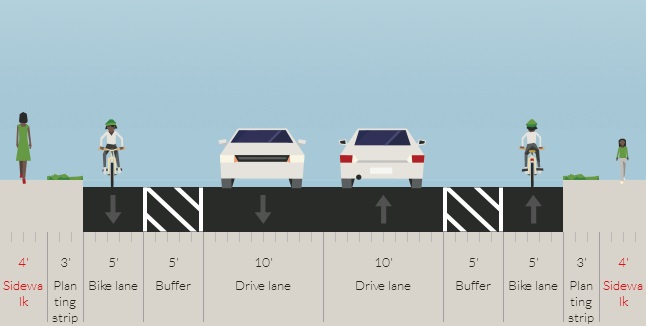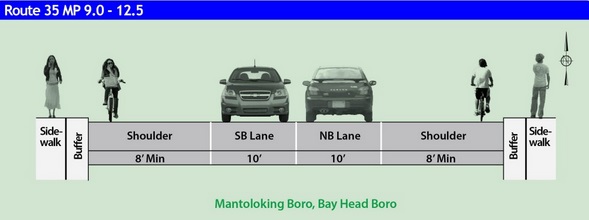

No, it wasn’t an April Fools’ prank. On April 1, the New Jersey Department of Transportation revealed revised plans for the $265 million, 12.5-mile Route 35 Reconstruction Project. The original reconstruction plan for the Hurricane Sandy-damaged Route 35, which was first announced in February 2013, was touted as a complete streets project, but it provided little in the way of bike accommodations other than paved shoulders in some segments of the right of way.
The updated plan includes 10 miles of bike accommodations — mostly dedicated bike lanes, with shared lane markings or “sharrows” in some locations. The change comes after a year of advocacy by Tri-State, along with the New Jersey Bike & Walk Coalition and Greater Philadelphia Bicycle Coalition, to assure that this project serves as an example for New Jersey and rest of the nation of how complete streets can be implemented.
The project, which extends through eight municipalities, has been divided into three sections:
Mileposts 0-4 (Berkeley, Seaside Park, Seaside Heights and Toms River)
Route 35 North, from the entrance to Island Beach State Park in Berkeley through 6th Avenue in Toms River, will have a continuous bike lane of either four feet or five feet in width for all but 11 blocks. These 11 blocks will include sharrows.
On Route 35 South, from 6th Avenue in Toms River to Grant Avenue in Seaside Heights, bicyclists will have a four-foot dedicated lane, however, between Grant and Lincoln Avenues, cyclists will have shared road infrastructure. From Lincoln Avenue, southbound cyclists would be diverted one block east to Boulevard, which has no bicycle accommodations, and then rejoin Route 35 south of K Street, where there will be a four-foot-wide bike lane all the way until the entrance to Island Beach State Park in Berkeley.
Mileposts 4-9 (Lavallette, Toms River and Brick)
This five-mile section of Route 35 is will see five-foot bike lanes that will be marked alongside the northbound and southbound travel lanes, with the remaining shoulder space serving as a buffer between parked cars and the bicycle lanes.
Mileposts 9-12.5 (Mantoloking and Bay Head)
In this northernmost section, the northbound and southbound roadways reunite, with two lanes of traffic in each direction. In Mantoloking there will be five-foot bike lanes on both sides of Route 35, buffered from vehicular travel lanes with five-foot-wide painted buffers.
Parking is permitted, however, along the highway shoulders in Bay Head, which doesn’t leave enough space for dedicated bike lanes. As NJDOT notes in the plan, bicycle accommodations in Bay Head remain only “conceptual,” so in the meantime, “Share the Road” signage and sharrows will be installed.
Cyclists aren’t the only winners
Tri-State and its partners are currently reviewing the pedestrian accommodations included in the updated plan, but according to NJDOT’s press release, new pedestrian accommodations will include:
- 63,000 linear feet of new or rebuilt sidewalk, including a continuous sidewalk along the entire 12.5 miles of the northbound lanes
- 1,200 ADA-compliant curb ramps
- 200 pedestrian countdown signals
- The addition of a Pedestrian Hybrid Signal just north of the Route 37 interchange to promote safe pedestrian access to the bay in Seaside Heights
These updated plans are a vast improvement over what was presented last year, but some sections still lack dedicated bicycle accommodations and continuous sidewalks. Fortunately, advocates aren’t alone in pushing for more pedestrian and bicycle infrastructure: Both Brick and Lavallette passed Resolutions urging NJDOT to include continuous sidewalks on Route 35 south.

any rubber bollards?
Congratulations on this long fought victory. What’s most tragic is that you had to fight with NJDOT for this is the first place. Also the proposal that NJDOT has given you is far from ideal and should have been the beginning of negotiations, not the end.
There are many things about NJDOT’s proposal that leaves me concerned. First is the use of substandard 4 foot wide bicycle lanes in a number of locations in the southern section. AASHTO minimum (MINIMUM!) is 5 feet.
Second is the use of Sharrows elsewhere. Yes it may have been inevitable that they would be needed in the northern section of the project but real innovation would have eliminated parking on one side of the highway in Bay Head allowing room for a conventional bike lanes. Sharrows here are simply window dressing that won’t be used but allow NJDOT to say they did something. It would have been better still to have routed bikes off of Rt 35, like they did elsewhere, on the parallel Barnegat Lane, Clayton Ave and Lake Ave.
Finally, the seemingly excellent 5 foot bike lanes with a 5 foot buffer from traffic will likely fill with sand rendering them mostly useless. This highway is being built on a sand bar last I checked and anyone with the slightest experience with this area knows that the far right of the shoulder is always covered with sand. Also, any cyclist worth the salt on their brow knows the far right side of a shoulder is always filled with the most debris! The use of gore striping in the buffer will make it uncomfortable and very difficult to ride further to the center of the roadway. Hopefully I’m wrong and the new drainage system will clear the shoulders of sand but I highly doubt it. If I were in control of the project I would reduce the size of the buffer to a foot or two and mark the rest of the old shoulder a bike lane. This might come to a shock to NJDOT and its consultants but again 5 feet is MINIMUM width of a bike lane NOT the maximum. You can actually make them wider and many other road agencies do.
Again, congrats again to TriState, NJBWC and the BCGP on a well fought campaign. It’s a shame that the final proposal leaves me wanting and underwhelmed.
“however, between Grant and Lincoln Avenues, cyclists will have shared road infrastructure. From Lincoln Avenue, southbound cyclists would be diverted one block east to Boulevard, which has no bicycle accommodations”
“In this northernmost section, the northbound and southbound roadways reunite, with two lanes of traffic in each direction. In Mantoloking there will be five-foot bike lanes on both sides of Route 35, buffered from vehicular travel lanes with five-foot-wide painted buffers.”
Cycling alongside a four-lane highway? Being diverted a block east to a road with (also) no bicycle accommodations? This does not sound pleasant at all — nor safe.
So this is what is considered a victory? I do realize this is better than nothing, but for the cycling community to be ecstatic about this only shows how pathetic New Jersey is regarding real cycling infrastructure. So much for Complete Streets!
[…] At a rate of $50,000 per mile, New Jersey could have 20 miles of new bike lanes, like the ones that will be installed on Route 35 in Ocean […]
[…] 35. Back in 2013, Tri-State was critical of the New Jersey Department of Transportation’s plan to rebuild Route 35 without any bicycle facilities, despite the fact that it’s a popular […]
Short and sweet. What genius designed the northbound segment through Lavallete? Angled parking with no view for drivers to see oncoming bikers. Someone is going to get killed.